The Wooden Bee and the Story of the Auca Five
Here is my modest contribution to the Year of the Cat, and it is simultaneously a legacy build. The former is tenuously justified by the fact that the model in question bears the nickname “Cub” (the PA-14 Piper Cub, to be precise). I have searched high and low and though some have, post-production, associated the plane with a bear cub, I could find nothing official from Piper Aircraft to that effect. Since big cats have cubs, I'm calling it good to go for the group build, and let all detractors hold their peace.
As far as the legacy aspect goes, the model was built as a gift for my son, Joseph, in memory of a visit we made together in the spring of 1994 to a location and community pertinent to this particular plane. There's a story to be told which I will get to shortly. But first, the model itself.
The kit was Minicraft's 1/48 PA-18 Super Cub. I have to say, the kit itself doesn't have much to commend it other than it fit the bill for what I was trying to accomplish. Parts fit poorly, canopy was much too thick, instructions were ambiguous and poorly printed. It came with plenty of decal options, but as I printed my own for the serial numbers anyway (I only used the striping on the side from the kit) that was moot. The kit was also pretty expensive, all things considered (I've gotten my hands on a Tamiya P-47 on Ebay for half the price, for some perspective). Since there were so few parts it was a quick build, other than the fact that I had to slightly modify the cockpit interior and the aft section of the canopy to resemble the PA-14; the PA-18 and the PA-14 were/are essentially the same in respect to exterior dimensions. I painted the exterior with white primer then using rattle can enamel.
Why did I go out of my way to build this kit? The answer lies in the backstory, and my own very modest connection to it. On the date of this posting 62 years ago, January 8, 1956, five young men met their deaths in the Ecuadorian rainforest. They were missionaries, and they were attempting to reach a stone age Indian tribe which itself was on the verge of extinction due to internal blood-feuding. It was a PA-14 that had taken them to the remote spot near the headwaters of the Amazon.
The five men were Nate Saint, Jim Elliott, Ed MCully, Pete Fleming, and Roger Youderian. All were in their late 20s or early 30s, all were recently married; most had young children. They had varied backgrounds. Nate Saint, the pilot, had been an Army man late in WW2, but never left stateside duty; Youderian was a paratrooper who fought at the Battle of the Bulge; Elliott was a conscientious objector from a pacifist church group, but was too young to have served in the military anyway. These men had made friendly contact with a group of Indians known as “Aucas” to other Indians (meaning, “Savage Killers”), but called themselves Huaoranis (also spelled Waorani for easier pronunciation). Their settlement was located on the Curaray River (a tributary of the Napo, which eventually flows into the Amazon) deep in the remote jungle basin east of the Andes Mountains. Saint, a highly skilled pilot, fully utilized the PA-14's capacity as a bush plane, landing on a sandbar that revealed itself when the Curaray was low (this spot was dubbed “Palm Beach” for the large palms that grow adjacent to it). While the men knew the Indians were dangerous, initial contact seemed promising and they continued to make brief visits and built an outstation treehouse.
Saint and his PA-14
The above photo of three of the five men and the PA-14, taken from the sandbar on "Palm Beach," was snapped hours before things took their fateful turn.
In early January, 1956, all five flew into Auca territory together, set up a radio from their tree house, and began a concerted dialogue with some of the Indians. They took a wooden model of the PA-14 to illustrate the need for an airstrip. Photos and film footage were taken. Yet the missionaries did not know that an internal struggle was brewing within the tribe itself, and the result was that in an effort to save his life from the spears of his own people, the Indian they had spoken with accused the men of misleading him. The Indians overcame their argument by joining forces and deciding it would be better (this time) to kill the outsiders than each other. On January 8, the Aucas attacked. Though the missionaries had a gun, they refused to defend themselves. All five were speared and hacked to death.
Above, Nate Saint and a Huaorani Indian they nicknamed "George," posing with Saint's scratch built wooden model of the PA-14, used to demonstrate the need for a landing strip. Note the careful detail on the tail, down to serial numbers. Short hours after this photo was taken George participated the missionaries' murder; he himself was later speared by his own people.
The Indians stripped the plane of anything they deemed valuable and threw the men's bodies in the river. Lack of radio contact from the men resulted in a search, and the story was featured in Life magazine; the U.S. Army sent in Panama-based personnel. The search party discovered four of the corpses and the camera (which documented the contact the men had had the day before their deaths, hence these pictures), buried the men, and left the area without further contact with the Indians.
The death of the missionaries was judged variously as a tragedy, a martyrdom, and a folly. How could they have so misjudged the situation, leading to their own deaths and such grief for their families? Didn't their actions simply further isolate the tribe? To this day the value of their actions is still debated.
What no one debates, however, is the story of redemption that followed. In a remarkable turn of events, Rachel Saint (Nate's sister), and Betty Elliott (Jim's widow) reached out to the tribe through its womenfolk and subsequently began a mission among them. The Indians ultimately expressed remorse for the killings, realizing they had done wrong in killing men who meant them no harm. Eventually nearly the entire tribe converted (the women baptized the men who had murdered their loved ones), with the result that the culture of blood-feuding ceased and the Indians began to experience full lifespans (at the time of the murders there was no one in the tribe older than 30). Medicine, education, and infrastructure followed. To this day the only real access to the area is by air.
My connection is that while serving in Ecuador in 1994, we took a vacation in the Amazon Basin. When we arrived at the Missionary Aviation Fellowship base in Mera Shell, Ecuador (the very place Saint used as his base), we heard that Rachel, now in her 80s, was at Palm Beach. We decided to fly out to see her, taking the very route those men had taken years before. We flew low over Palm Beach (the sandbar was obscured by high waters), landed on the airstrip they had envisioned, were greeted by the Indians (one of them, now an old man, had participated in the attack that day), heard some stories, and said our goodbyes. Rachel died about six months later, but before she did, the PA-14 was discovered under the sands at Palm Beach. Its remains were sent to the MAF headquarters in Idaho.
I'm at the right with the beard, my son wears the red T-shirt; Rachel Saint, Nate's sister, is the white-haired lady at the left, and a Huaorani child stands at the rear.
The remains of Saint's plane, now in a museum near Boise, Idaho.
For more on this story, see the popular movie The End of the Spear or the (much better) documentary movie Beyond the Gates of Splendor, or read up on it through various sites on the internet.
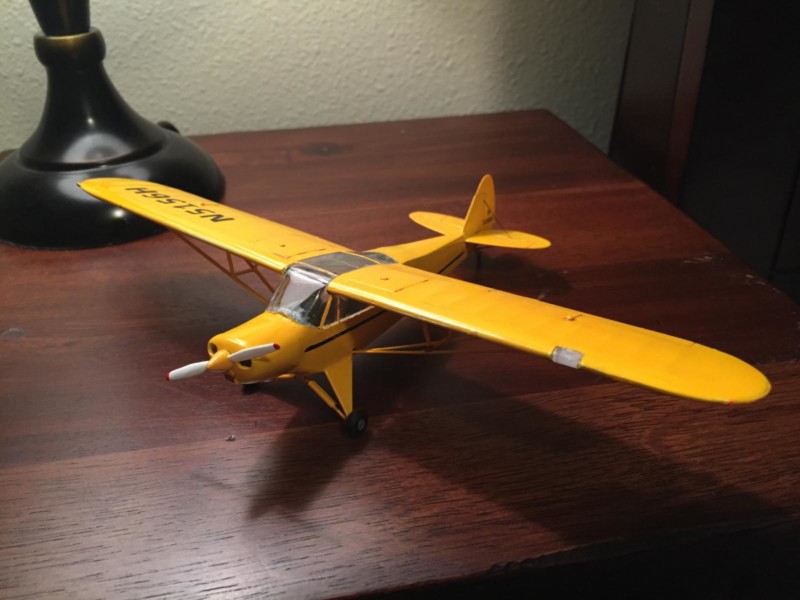
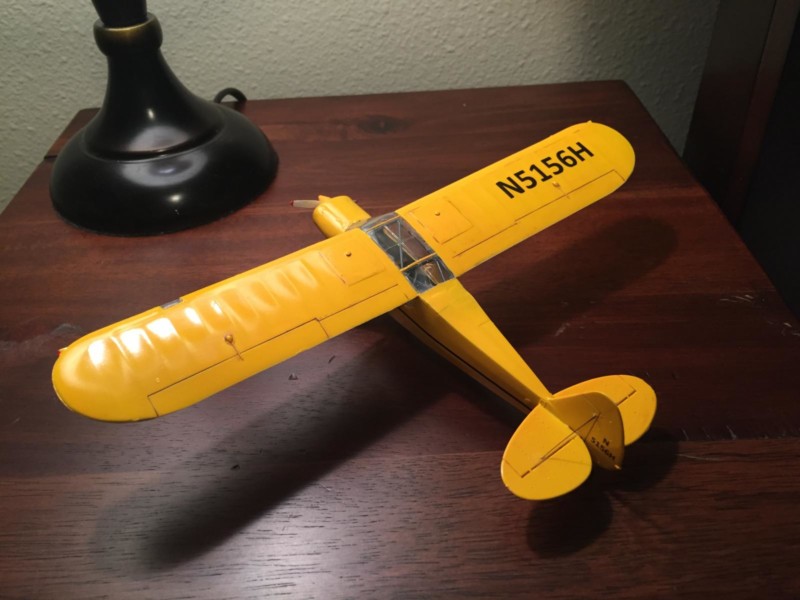
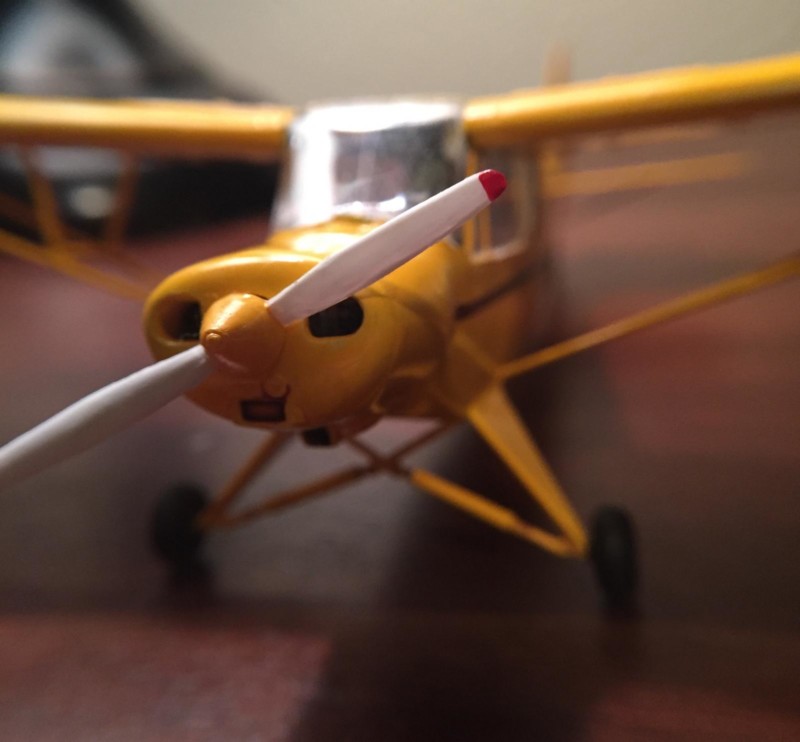
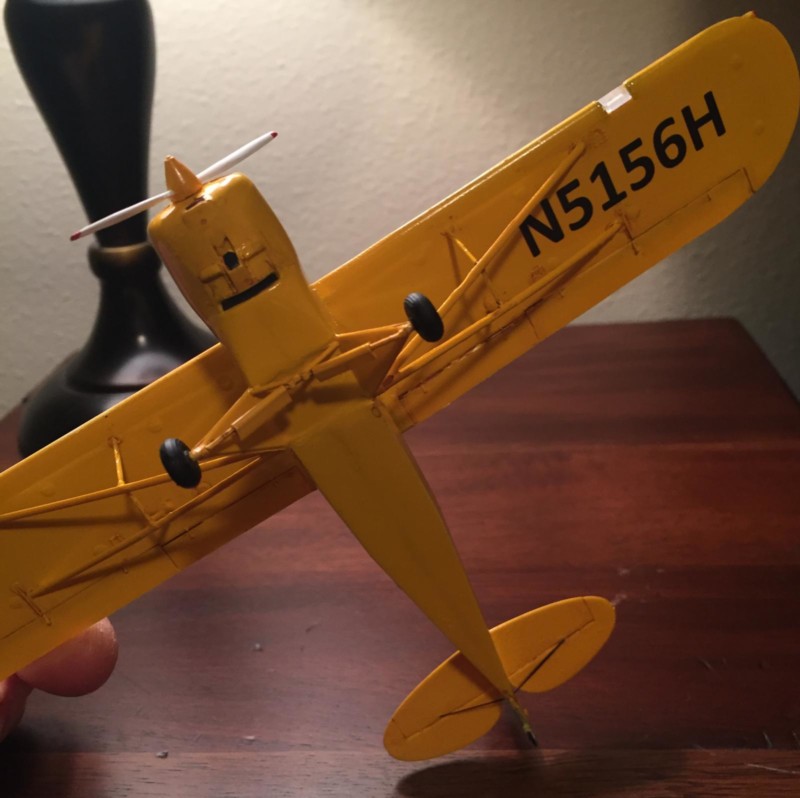
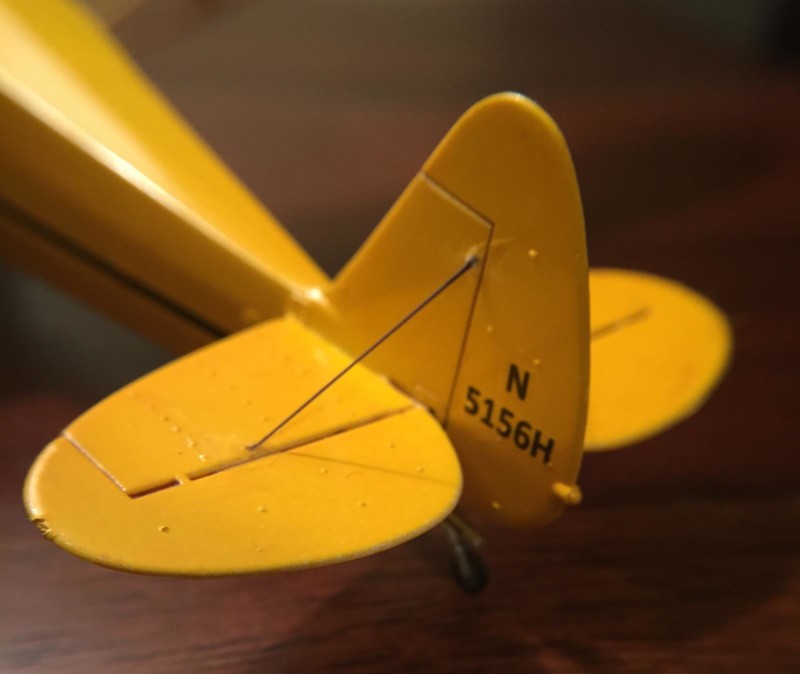
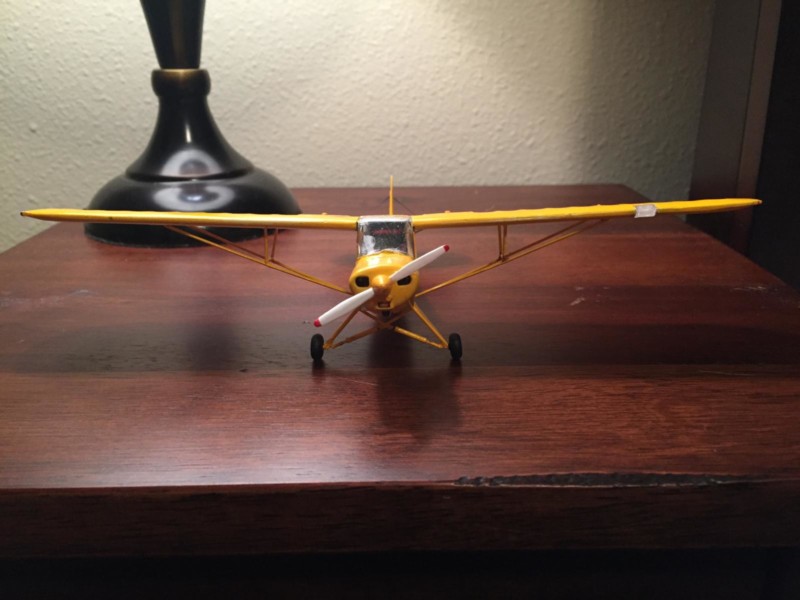
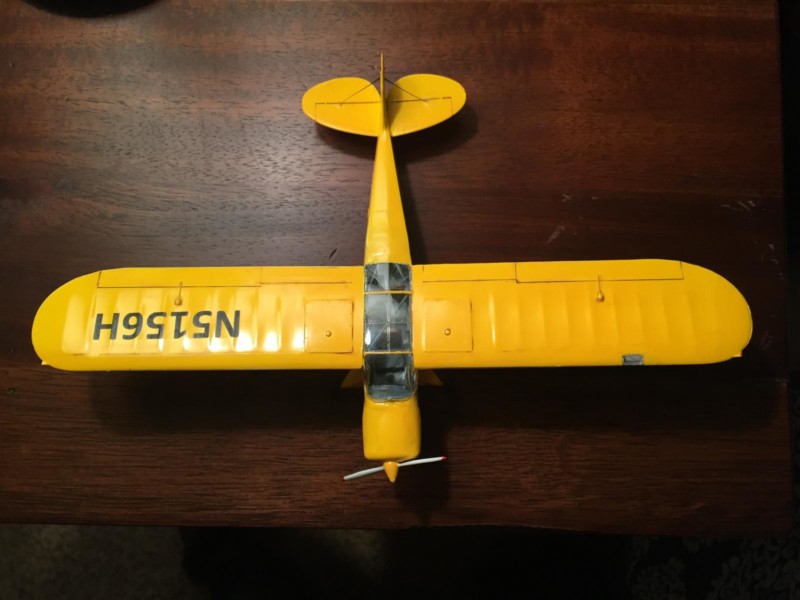
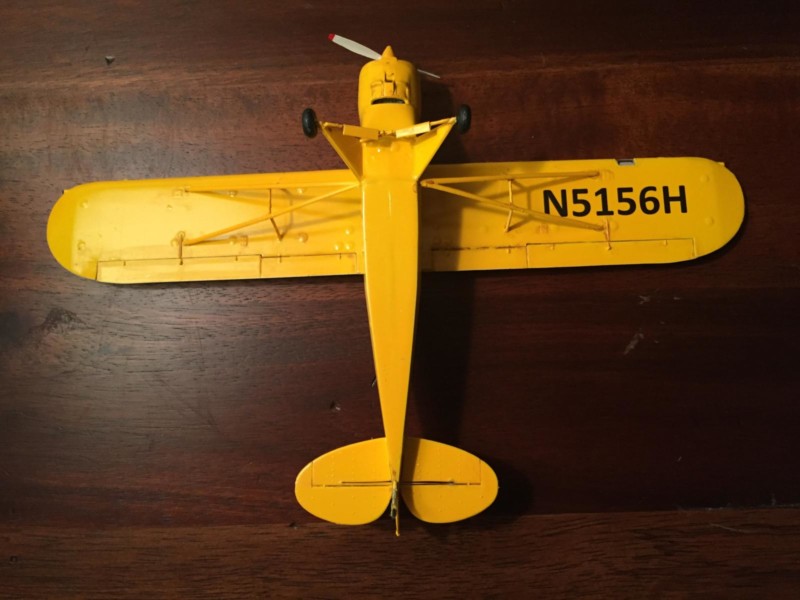
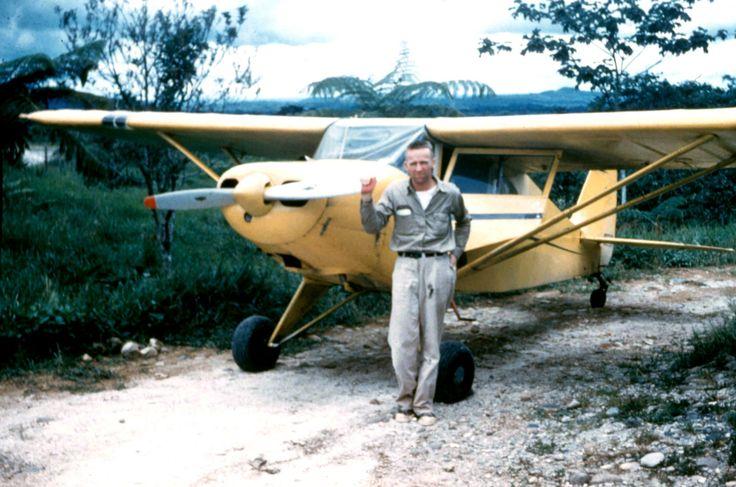
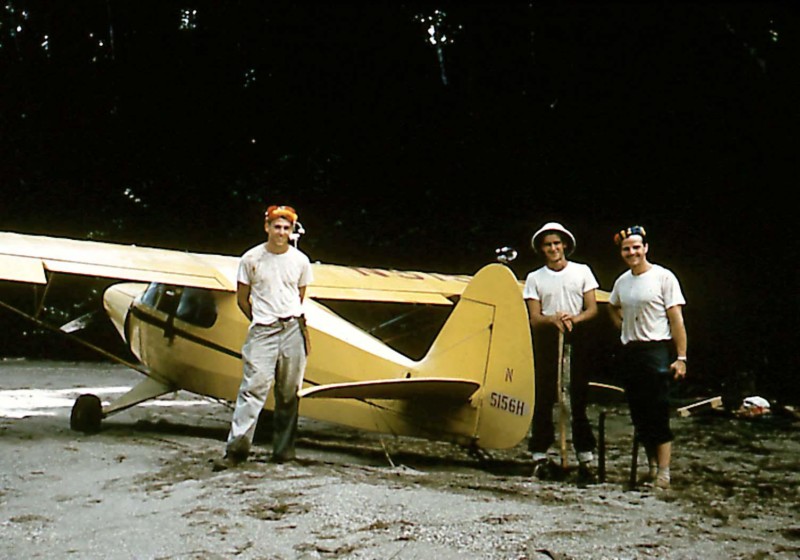
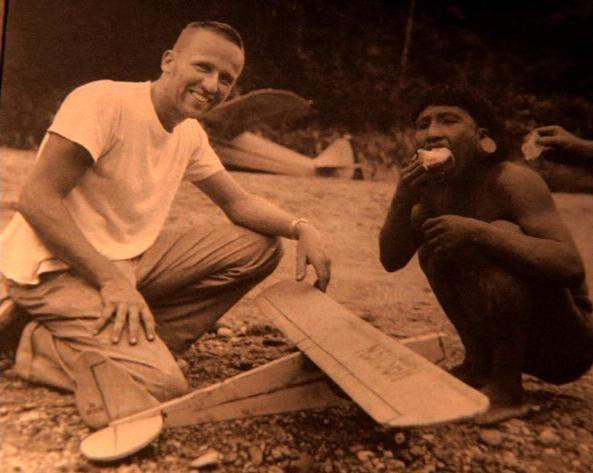
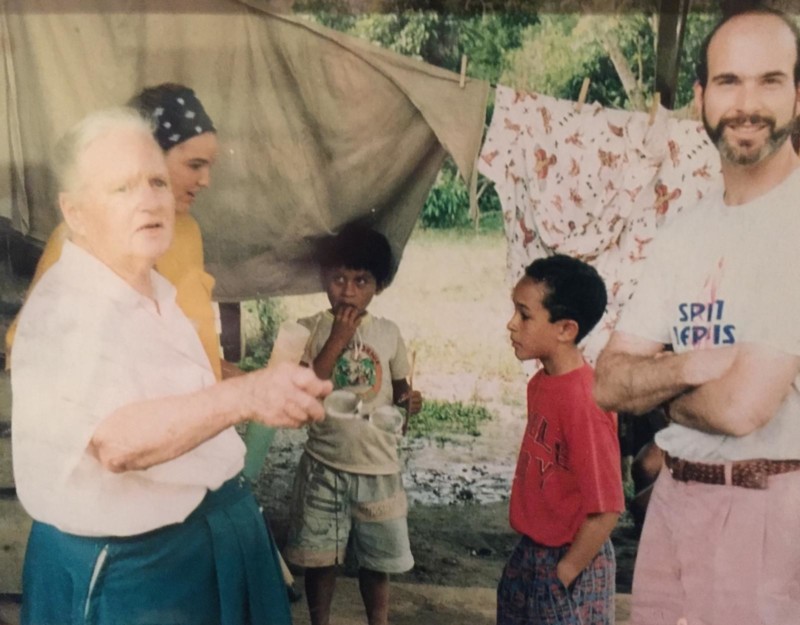
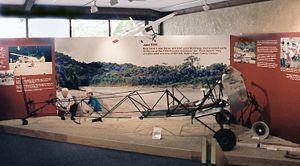
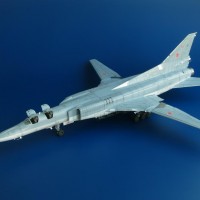
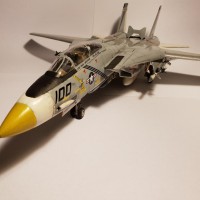
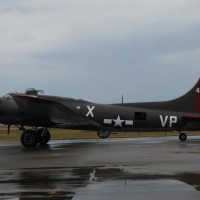
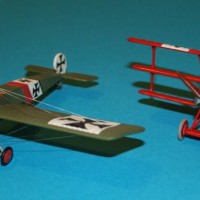
Wow David... This is a tragic (and sad) but also an amazing story. The world is obviously not always a friendly place, but thankfully good prevailed in the end.
Your Cub is a welcome addition to the Year of the Cat...and it turned out fantastic.
Thank you VERY much for sharing this with us. The story and the model plane.
Thanks, Louis. It seems the only way to get them to stop killing each other was for someone to die without retaliating. And that's what did it.
I agree wholeheartedly with Louis' assessment of your posting. Great!
As an aside, I'd always heard (no disrespect intended) that a Cub can fly just fast enough to kill ya.
Much appreciated, Craig!
I had the DVD of that story and am quite familiar with it. Your model does justice to their memory and it is quite impressive.
Thanks, Paul. Rachel told us some stories that I'm choosing not to tell here that would give you goosebumps. Amazing stuff.
Great story and build, a tribute and a sad story.
Much appreciated, Marc.
You know, the redemption is even sweeter than I've described, but felt I needed to cut it off. Nate Saint's children were eventually accepted by the converted tribespeople as family, and they were baptized by the men who killed their father. They are still dear friends.
You just cannot make that stuff up.
What a great testimonial with your build. A story that really tugs at your heart. Thanks for sharing that.
Thanks, brother. As Elliott's journal quotes, "He is no fool to give up what he cannot keep to gain what he can never lose."
Beautiful build, great narrative, David! Thanks for sharing.
Thanks, Jeff!
That's quite a story and adds real emphasis to your Cub. Well done Doc.
Thanks, Tom. As I told Louis, your encouragement has helped me press into projects I would have tossed before.
David, I also have a personal interest in your project and the subject of this post. Years ago, I worked with the production company that helped produce The End of the Spear, as well as a live stage presentation called Dayuma, which was about one of the Waorani women who was a part of the events described, and was outcast from the group, but later returned to help evangelize the tribe. I had the pleasure of meeting Steve Saint (Nate's son) and one of the Waorani men who participated in the slaying. It is an incredible story of love, commitment and sacrifice for a calling beyond oneself! Thanks for sharing.
By the way - for clarification for others, I noticed you forgot to mention where the term "wooden bee" came from. This was what the Waorani thought of the yellow critter circling in the skies above the jungle and the river.
Greg, you are spot on: I should've mentioned that "wooden bee" was the name the Huaoranis gave to the PA-14.
As for Dayumae (another spelling), I met her in April, 1994 during our visit. She has since passed away. Rachel explained that her entire family had been wiped out by the blood-feuding, and she escaped to "the cannibals" (i.e., the non-Huaorani world), learned Spanish, and became the real bridge that Rachel used to reach the tribe.
That is very cool that you were involved in that production. Small, small world.
Very small indeed!
David, I really enjoy and appreciate seeing the builds here that are touched by personal experience and that have a compelling story. Firstly, congratulations on a great build of difficult kit! It is another one of those builds where seeing photographs of the actual aircraft and then the model brings a lump to your throat!
I imagine the emotions ran little high as you were putting it all together! I wouldn't want to add to the comment on the 'history' recounted, I'd simply say that the human capacity to forgive and reconcile can be incredible.
David, I really enjoy and appreciate seeing the builds here that are touched by personal experience and that have a compelling story. Firstly, congratulations on a great build of a difficult kit! It is another one of those builds where seeing photographs of the actual aircraft and then the model brings a lump to your throat!
I imagine the emotions ran little high as you were putting it all together! I wouldn’t want to add to the comment on the ‘history’ recounted, I’d simply say that the human capacity to forgive and reconcile can be incredible.
Paul, you are right. It was an emotional build. When we drove into Shell all those years ago, our intention was to just see the base and some of the (by then very decrepit) buildings used by Saint and Elliott. Then the MAF guys told us that Rachel was there--out at Palm Beach. For us, she was a living legend. She had cancer, and wanted to finish her life among the people she loved. So we flew out there. Lots of memories, banking in over the Curaray then leaning amidst the people who ultimately were redeemed by those men. They readily acknowledge they would have wiped each other out completely had not something changed them. It was cool to see it firsthand. This little build is my homage to them, and to that chapter of my life. I go to Ecuador regularly, but that corner of the country is a different world.
Wow,I can't say much more than already has been said, Thank you for sharing this.
Great model, incredible story.
I do not know how I missed this. Well, I do, last New Year was...busy.
Anyway, a really nice coincidental tie-in with 'On This Day...' and a pleasure to read through the backstory to what is also a great build. Like Paul, I am a really big fan of personal builds and this is an amazing story with so many scarcely believable elements. Bittersweet in the extreme.
'Liked' very, very much.
Thanks, David. We are brothers by another mother for sure.